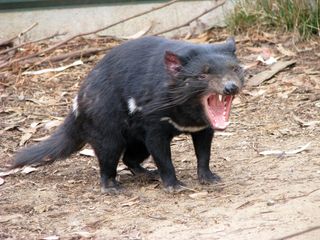Tasmanian Devil Animals What Is The Habitat Of The Tasmanian Devil?
Facts Almost Tasmanian Devils

Tasmanian devils are minor marsupials with ratlike features, sharp teeth and coarse black or brown fur. Diminutive as it may be, don't be fooled: This brute has a fighting style that is quite intimidating.
Size
The real Tasmanian devil doesn't really resemble the famous cartoon character. It isn't the same size as humans, for case. Nor does it tempest through its environment like a swirling tornado. The Tasmanian devil is only 20 to 31 inches (51 to 79 centimeters) tall and weighs only 9 to 26 lbs. (4 to 12 kilograms).
Habitat
The Tasmanian devil is found on the island of Tasmania in Australia — an area of about 35,042 foursquare miles (90,758 square kilometers). Though Tasmanian devils tin live anywhere on the island, they prefer coastal scrublands and forests, according to National Geographic. But no matter what area of the island they inhabit, these animals slumber nether rocks or in caves, logs or burrows.
Habits
The cartoon Tasmanian devil does have one matter in common with the existent animal: poor temperament. When the devil feels threatened, it goes into a rage in which information technology growls, lunges and bares its teeth. It as well makes otherworldly screams that tin can seem very devil-like. It may exist due to this temper that the Tasmanian devil is a solitary animate being.
The Tasmanian devil is too nocturnal; it sleeps during the day and is awake at night. During the night, they sometimes journey up to 10 miles (16 km) to hunt, according to the San Diego Zoo.
Diet
The Tasmanian devil is the earth's largest carnivorous marsupial, co-ordinate to National Geographic. Most of the time, they eat birds, snakes, fish and insects. Oft, they feast on dead carcasses, called carrion. Sometimes, many devils converge on one carcass, and fighting ensues.
When they have a meal, Tasmanian devils don't waste material any part of the beast; they consume the bones, pilus, organs and muscle of their casualty.
Offspring
Tasmanian devils typically mate once a year in March. Mother devils have a gestation period of around three weeks, and the babies are born in April. She will accept up to fifty young at once. The young, called imps, are pink and hairless and but well-nigh the size of a grain of rice, according to the San Diego Zoo.
At birth, the imps must race to the female parent'southward pouch, where they compete for one of her four teats. Simply those four will have a chance of surviving; the others volition die due to malnourishment.
Babies stay in their pouch for four months. Once they come up out, they are weaned, and the female parent volition carry the imps on her back. Past eight to nine months, the imps are fully grown. Tasmanian devils alive five to eight years.
Classification/Taxonomy
Here is the taxonomy of Tasmanian devils, according to the Integrated Taxonomic Information Arrangement (ITIS):
- Kingdom: Animalia
- Subkingdom: Bilateria
- Infrakingdom: Deuterostomia
- Phylum: Chordata
- Subphylum: Vertebrata
- Infraphylum: Gnathostomata
- Superclass: Tetrapoda
- Class: Mammalia
- Bracket: Theria
- Infraclass: Metatheria
- Order: Dasyuromorphia
- Family: Dasyuridae
- Subfamily: Dasyurinae
- Tribe: Dasyurini
- Genus:Sarcophilus
- Species:Sarcophilus
- Subspecies:Sarcophilus harrisii dixonae,Sarcophilus harrisii harrisii
Conservation status
According to the International Union for Conservation of Nature's Red Listing of Threatened Species, Tasmanian devils are endangered, and their population numbers are declining. In 2007, the IUCN estimated that the population may have been around 25,000 adults.
The Tasmanian devil's population has declined by at to the lowest degree 60 pct since 2001 due to a cancer called devil facial tumor illness (DFTD). DFTD causes tumors to course on the devil's facial area, making it difficult for them to swallow. Somewhen, the beast starves to death. The Salve the Tasmanian Devil Programme is an initiative created by the Australian and Tasmanian governments to save the animals from DFTD.
Other facts
The Tasmanian devil's front legs are longer than its back legs.
Even though information technology is minor, it has 1 of the virtually powerful bites in the fauna globe, due to its muscular jaw, according to National Geographic.
Tasmanian devils shop extra fat in their tails.
Though awkward on the ground, Tasmanian devils are proficient tree climbers.
Additional resources
- Australia Department of Parks, Water and Energy: Tasmanian Devils
- Australian Parks and Wildlife Service: Tasmanian Devils
- Save the Tasmanian Devil
- University of Michigan Museum of Zoology: Tasmanian Devil
Source: https://www.livescience.com/27440-tasmanian-devils.html
Posted by: renfroeshunt1950.blogspot.com


0 Response to "Tasmanian Devil Animals What Is The Habitat Of The Tasmanian Devil?"
Post a Comment